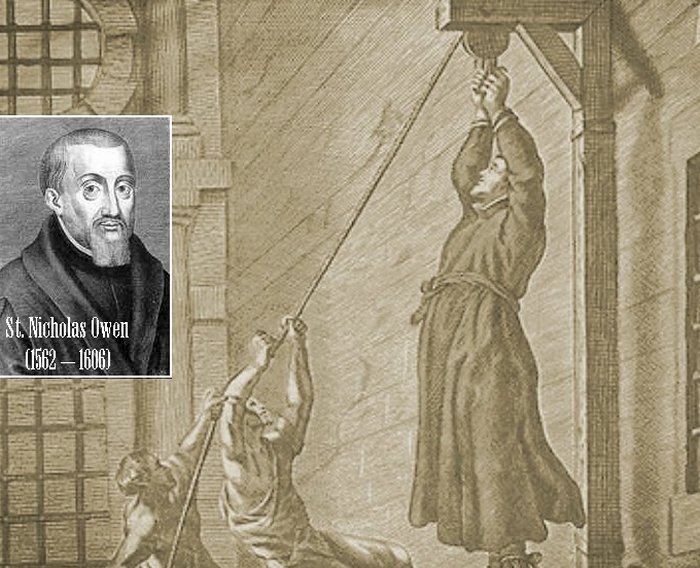Nicholas Owen ‘Little John’ Who Paid Highest Price For His Ingenious, Camouflaged Places To Hide
A. Sutherland - AncientPages.com - ‘Priest holes’ saved many lives of Catholic priests and became their sanctuaries in times of persecution during England’s Anti-Catholic times.
They were so unusual and perfectly camouflaged that they still surprised modern inventors and designers.
They were designed and created by St. Nicholas Owen (c. 1562 – 1/2 March 1606), a Jesuit, talented stonemason, and carpenter’s son from Oxford.
Owen was a defender of persecuted Catholics. He entered the Jesuit Order in 1588, and for the next 18 years, until his martyr died in 1606, he devoted himself to constructing safe and effectively concealed hiding places for priests in danger.
In these sanctuaries, built-in houses of Catholic families, priests, altar vessels, and related objects could survive.
Owen worked in dangerous times during the reign of Queen Elizabeth I of England (also known as "Good Queen Bess").
Historical records confirm that persecution of Catholics began before Henry VIII's time, when Pope Paul III refused to give him a divorce from Catherine of Aragon. This forced Henry to break with Rome.
Owen disguised the entrances to the priest-holes, with such skills that priests lived in them, protected from martyrdom, for years. Image credit: The Catholic Catalogue
Anti-Catholic persecutions continued during the reign of Elizabeth I (1558-1605) and included eliminating the celebration of Mass, recitation of the Rosary and Catholic prayers were forbidden at the risk of being extradited, priests would be sentenced to a year in prison, jailed for life or put to death, by hanging, drawing, and quartering.
Repression also affected those who did not swear allegiance to the English ruler and did not recognize his supremacy over the Church in England.
Another very harsh law was passed that punished with death any Catholic who should convert a Protestant.
Nicholas Owen—one of the most skilled builders of priest holes—devoted the greater part of his life to helping persecuted Catholics. He could accommodate up to 10 people in one hiding place, and none of his priest holes was the same.
In case of danger, the persecuted priests could escape by underground tunnels up to several kilometers away from the house. Several entrances and exits camouflaged the real hiding place.
Under the name of "Little John", "Draper" or "Little Michael", he often traveled from one house to another, and in exchange for only the necessities of life as payment, he created hiding places. During the daytime, Owen worked as a traveling carpenter and at nights built hide places camouflaged under basements, under floors, and between walls.
Famous priest-holes are found at Baddesley Clinton in Warwickshire, Naworth Castle in Cumbria, at Harvington Hall, near Kidderminster in Worcestershire, Ufton Court, near Reading, Scotney Old Castle in Kent, Oxburgh Hall in Norfolk, Thurnham Hall near Lancaster, Baddesley Clinton and Coughton Court in Warwickshire and many more.
Many Catholic priests survived thanks to people like Nicholas Owen, who sacrificed his life to hide them.
In “Secret Chambers and Hiding Places”, Allan Fea (1860-1956) wrote about Nicholas Owen’s work:
“With incomparable skill,” says an authority,
“he knew how to conduct priests to a place of safety along subterranean passages, to hide them between walls and bury them in impenetrable recesses, and to entangle them in labyrinths and a thousand windings…”
Many believe that some of them may still be undiscovered. Today, modern technology such as 3-D laser scanning may help uncover the ingenious work left by a 16th-century English martyr, Nicholas Owen.
Nicholas Owen was arrested in 1594 and interrogated, but despite torture, he did not reveal anything. Early in 1606, Owen was arrested a final time and placed in the Tower of London, where he was tortured to death by prison authorities.
He died in the night between 1 and 2 March 1606. In 1927, Nicholas Owen was beatified and finally canonized in 1970 by Pope Paul VI.
Updated on March 23, 2024
Written by – A. Sutherland AncientPages.com Staff Writer
Copyright © AncientPages.com All rights reserved. This material may not be published, broadcast, rewritten or redistributed in whole or part without the express written permission of AncientPages.com
Expand for referencesMore From Ancient Pages
-
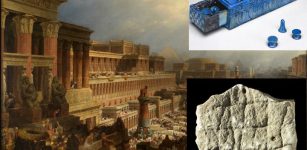 4,500-Year-Old Board Games And Game Pieces Unearthed At Gath
Archaeology | Jun 19, 2022
4,500-Year-Old Board Games And Game Pieces Unearthed At Gath
Archaeology | Jun 19, 2022 -
 Fossil Study: Coelacanths Thrived In Switzerland After A Mass Extinction
Fossils | Jul 28, 2023
Fossil Study: Coelacanths Thrived In Switzerland After A Mass Extinction
Fossils | Jul 28, 2023 -
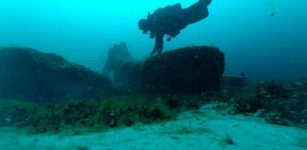 Lake Huron Was Home To A 9,000-Year-Old Civilization – Underwater Structures And Artifacts Reveal
Archaeology | Jun 17, 2021
Lake Huron Was Home To A 9,000-Year-Old Civilization – Underwater Structures And Artifacts Reveal
Archaeology | Jun 17, 2021 -
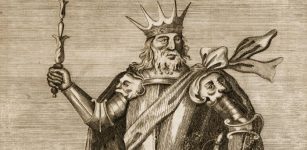 Brian Boru – Famous And Brave Irish Hero Who Dared To Chase Off The Vikings
Featured Stories | Jun 14, 2022
Brian Boru – Famous And Brave Irish Hero Who Dared To Chase Off The Vikings
Featured Stories | Jun 14, 2022 -
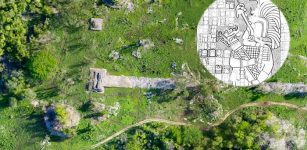 The 100-Kilometer-Long Stone Highway That Connected Ancient Maya Cities Revealed By LIDAR
Archaeology | Feb 25, 2020
The 100-Kilometer-Long Stone Highway That Connected Ancient Maya Cities Revealed By LIDAR
Archaeology | Feb 25, 2020 -
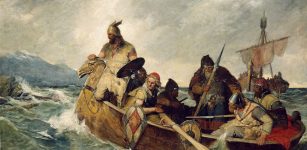 Evidence Scots And Irish Settled Iceland A Century Before The Vikings?
Featured Stories | Jan 7, 2023
Evidence Scots And Irish Settled Iceland A Century Before The Vikings?
Featured Stories | Jan 7, 2023 -
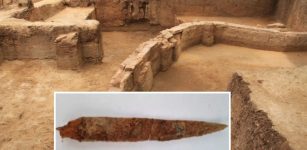 Rare Well-Preserved 2,500-Year-Old Dagger Linked To The Keeladi Civilization Discovered In Tamil Nadu, India
Archaeology | Aug 13, 2021
Rare Well-Preserved 2,500-Year-Old Dagger Linked To The Keeladi Civilization Discovered In Tamil Nadu, India
Archaeology | Aug 13, 2021 -
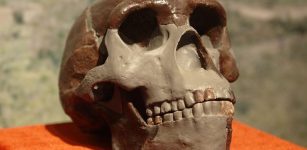 Sinuses Reveal More About The Evolution Of Ancient Humans
Archaeology | Oct 29, 2022
Sinuses Reveal More About The Evolution Of Ancient Humans
Archaeology | Oct 29, 2022 -
 Ancient City Of Adab That Flourished In North Sumer
Civilizations | Jul 19, 2017
Ancient City Of Adab That Flourished In North Sumer
Civilizations | Jul 19, 2017 -
 Unknown Ancient God Was Worshipped In Mesopotamia – Sacred Texts And Archaeology Reveal
Civilizations | May 9, 2018
Unknown Ancient God Was Worshipped In Mesopotamia – Sacred Texts And Archaeology Reveal
Civilizations | May 9, 2018 -
 Complete Neolithic Cursus Discovered On Isle of Arran, Scotland
Archaeology | Sep 7, 2023
Complete Neolithic Cursus Discovered On Isle of Arran, Scotland
Archaeology | Sep 7, 2023 -
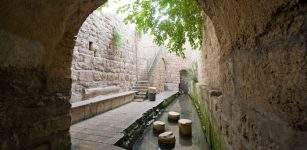 Biblical Pool Of Siloam In The City of David To Be Excavated And Opened To The Public
Archaeology | Jan 2, 2023
Biblical Pool Of Siloam In The City of David To Be Excavated And Opened To The Public
Archaeology | Jan 2, 2023 -
 Sobek: A 2,500-Year-Old Mummified Nile Crocodile – On Display At The British Museum
Archaeology | Dec 9, 2015
Sobek: A 2,500-Year-Old Mummified Nile Crocodile – On Display At The British Museum
Archaeology | Dec 9, 2015 -
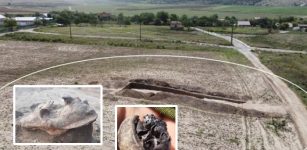 Archaeologists Make An Unusual Find In A 2,000-Year-Old Romanian Burial Mound
Archaeology | Jul 12, 2023
Archaeologists Make An Unusual Find In A 2,000-Year-Old Romanian Burial Mound
Archaeology | Jul 12, 2023 -
 Ancient Hindu Sheetal Temple Vandalized – Lord Shiva And Elephant God Ganesha Statues Destroyed
News | Nov 3, 2020
Ancient Hindu Sheetal Temple Vandalized – Lord Shiva And Elephant God Ganesha Statues Destroyed
News | Nov 3, 2020 -
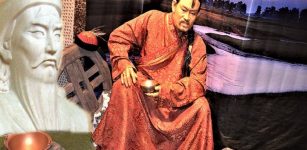 Jamukha: Mongolian Leader, Military And Childhood Friend Of Genghis Khan But Not Forever
Featured Stories | May 8, 2019
Jamukha: Mongolian Leader, Military And Childhood Friend Of Genghis Khan But Not Forever
Featured Stories | May 8, 2019 -
 Secrets Of Mica Chambers Of Teotihuacan
Ancient Technology | Jun 12, 2020
Secrets Of Mica Chambers Of Teotihuacan
Ancient Technology | Jun 12, 2020 -
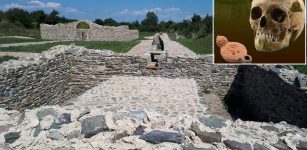 Ancient DNA Analysis Shows How The Rise And Fall Of The Roman Empire Shifted Populations In The Balkans
DNA | Dec 8, 2023
Ancient DNA Analysis Shows How The Rise And Fall Of The Roman Empire Shifted Populations In The Balkans
DNA | Dec 8, 2023 -
 The Mysterious Books Of Prophecies Of The Knights Templar – Where Are They Hidden?
Featured Stories | Mar 26, 2022
The Mysterious Books Of Prophecies Of The Knights Templar – Where Are They Hidden?
Featured Stories | Mar 26, 2022 -
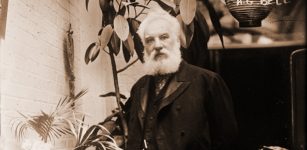 On This Day In History: Eminent Scottish Inventor Graham Bell Born – On Mar 3, 1847
News | Mar 3, 2017
On This Day In History: Eminent Scottish Inventor Graham Bell Born – On Mar 3, 1847
News | Mar 3, 2017

